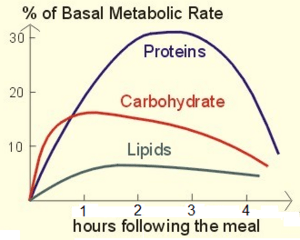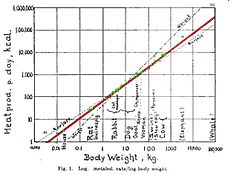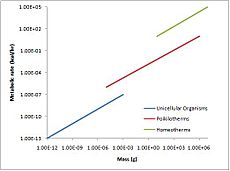Metabolic rate facts for kids
Metabolic rate is how fast your body uses energy. Think of it like your body's engine: it's the speed at which it burns fuel. This energy is used for everything you do, from running to just breathing.
Basal metabolic rate (BMR) is the amount of energy your body uses when it's completely at rest. This is the energy needed just to keep your vital organs working, like your heart, lungs, and brain. It's like the minimum fuel your car needs to stay running even when it's parked.
| Where Your Body Uses Energy | |
|---|---|
| Liver | 27% |
| Brain | 19% |
| Heart | 7% |
| Kidneys | 10% |
| Skeletal muscle | 18% |
| Other organs | 19% |
About 70% of the energy a human uses each day goes towards these basic life processes in their organs (check out the table!). Another 20% is used for physical activities, like walking or playing sports. The last 10% is used just for digesting the food you eat.
To get this energy, your body needs oxygen and nutrients from food, like carbohydrates, fats, and proteins. Your body breaks these down in a complex process to create special energy molecules called ATP. This process also releases carbon dioxide.
Contents
What is Basal Metabolism?
Basal metabolism is usually the biggest part of your body's total energy use. The energy used in this state is just enough to keep your most important organs working. This includes your heart, lungs, nervous system, kidneys, liver, intestine, and even your skin.
How Your Body Makes Energy
Most of the energy for your BMR is used to keep fluids balanced in your body's tissues. A smaller part is used for physical actions like digestion, your heartbeat, and breathing.
Your body gets energy by breaking down large food molecules into smaller ones. This process, which releases energy, is called catabolism. For example, when your body breaks down proteins into smaller pieces called amino acids, that's catabolism. This is also how warm-blooded animals, like humans, create body heat.
The opposite process, where your body builds up larger molecules from smaller ones, is called anabolism. Building proteins from amino acids is an example of anabolism.
Adenosine triphosphate (ATP) is like the energy currency of your body. It stores a lot of energy in its chemical bonds. When these bonds break, they release the energy needed for things like muscle movement.
Why Metabolic Rates Are Different
Everyone's metabolic rate is a bit different. One study in Scotland looked at 150 adults and found that their basal metabolic rates varied a lot. Some people used as little as 1027 calories per day, while others used as much as 2499 calories! The average was about 1500 calories per day.
Researchers found that a big part of this difference (about 62%) was due to how much lean body mass (muscle, bone, and organs, without fat) a person had. Other factors included the amount of fat in their body (6.7%) and their age (1.7%). About 26.7% of the difference couldn't be explained by these factors.
This means that even two people with the exact same amount of lean body mass can have different BMRs. For example, one study found two people with the same lean body mass (43 kg) but very different BMRs: one used 1075 calories per day, and the other used 1790 calories per day. That difference of 715 calories is like one person running a 10-kilometer race every single day!
How Size Affects Metabolism
The size of an animal greatly affects its metabolic rate. Scientists have been studying this for over a hundred years!
Looking at graphs of metabolic rate and body size shows a few interesting things:
- The metabolic rate of mammals (like humans, dogs, or elephants) changes in a regular way based on their body size.
- This relationship is not simply about the animal's body surface area.
- When you plot the metabolism of mammals against their body size on a special type of graph (called a log-log scale), it forms a straight line. This line has a slope of about 0.75.
- Later research showed that similar patterns exist for 'cold-blooded' animals (like reptiles) and even tiny single-celled organisms called protists.
Images for kids
See also
 In Spanish: Tasa metabólica basal para niños
In Spanish: Tasa metabólica basal para niños





